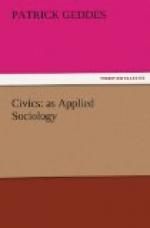These two forms of the same diagram, the simple and the more developed, thus suggest comparison with the scheme previously outlined, that of People, Affairs, Places (p. 68), and is now more easily reconciled with this; the greater prominence popularly given to People and Affairs being expressed upon the present geographic and evolutionary scheme by the ascending position and more emphatic printing (or by viewing the diagram as a transparency from the opposite side of the leaf).
In the column of People, the deepening of custom into morals is indicated. Emphasis is also placed upon the development of law in connection with the rise of governing classes, and its tendency to dominate the standards previously taken as morals—in fact, that tendency of moral law to become static law, a process of which history is full.
GOVERNING
=========
=========
CLASSES
=======
=======
^
|
FAMILY TYPES
============
----------------------------------------------
INDUSTRIES
==========
----------
----------------------------------------------
(FOLK-PLACE)
REGION (WORK PLACE) ------------
====== ------------ (TOWN)
| ======
|
V
--------------------------------------------
|
V
SURVEY ("SCHOOL”)
====== ==========
!—LANDSCAPE (CRAFT-TRADITION)
-----------------
(FOLK-LORE)
?--TERRITORY -----------
|
|
V
---------------------------------------------
|
V
[NATURAL [APPLIED [SOCIAL
-------- ======== =======
SCIENCES] SCIENCES] SCIENCES]
--------- ========= =========
|
|
V
-------------------------------------------
| CUSTOMS
V -------
MORALS
======
GEOGRAPHY ECONOMICS ------
--------- ========= &
LAWS
====
====
In the present as in the past, we may also note upon the scheme the different lines of Place, Work and Folk on which respectively develop the natural sciences, the applied or [Page: 78] technical sciences, and finally the social sciences, and the generalising of these respectively.




